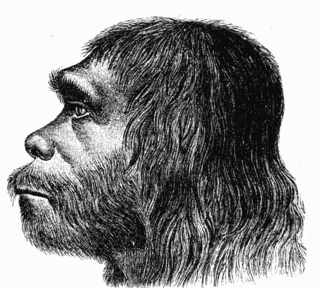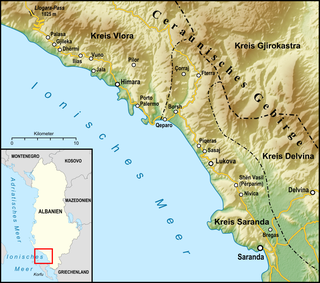
Harry Norman Turtledove is an American author who is best known for his work in the genres of alternate history, historical fiction, fantasy, science fiction, and mystery fiction. He is a student of history and completed his Ph.D. in Byzantine history. His dissertation was on the period AD 565–582. He lives in Southern California.

The Grand Canyon is a steep-sided canyon carved by the Colorado River in Arizona, United States. The Grand Canyon is 277 miles (446 km) long, up to 18 miles (29 km) wide and attains a depth of over a mile.

Canyoning is a type of mountaineering that involves travelling in canyons using a variety of techniques that may include other outdoor activities such as walking, scrambling, climbing, jumping, abseiling (rappelling), and swimming.

Tourism in Albania has been a key element to the country's economic activity and is constantly developing. It is characterized by its rich archaeological and cultural heritage dating back to the classical period when Illyrians and Ancient Greeks inhabited the region. Over the course of history, the territory of Albania was occupied and populated by Romans, Byzantines, Venetians and Ottomans. Notably the country features unspoiled beaches, mountainous landscapes, traditional cuisine, archaeological artifacts, unique traditions, low prices and the wild atmosphere of the countryside.

Black Canyon of the Gunnison National Park is an American national park located in western Colorado and managed by the National Park Service. There are two primary entrances to the park: the south rim entrance is located 15 miles (24 km) east of Montrose, while the north rim entrance is 11 miles (18 km) south of Crawford and is closed in the winter. The park contains 12 miles (19 km) of the 48-mile (77 km) long Black Canyon of the Gunnison River. The national park itself contains the deepest and most dramatic section of the canyon, but the canyon continues upstream into Curecanti National Recreation Area and downstream into Gunnison Gorge National Conservation Area. The canyon's name owes itself to the fact that parts of the gorge only receive 33 minutes of sunlight a day, according to Images of America: The Black Canyon of the Gunnison. In the book, author Duane Vandenbusche states, "Several canyons of the American West are longer and some are deeper, but none combines the depth, sheerness, narrowness, darkness, and dread of the Black Canyon."

The Colca Canyon is a canyon of the Colca River in southern Peru, located about 160 kilometres (99 mi) northwest of Arequipa. With a depth of about 1000 - 2000 m, it is one of the deepest canyons in the world. Its length is about 70 kilometres (43 mi). The Colca Valley is a colorful Andean valley with pre-Inca rooted inhabitants, and towns founded in Spanish colonial times, still inhabited by people of the Collagua and the Cabana cultures. The local people maintain their ancestral traditions and continue to cultivate the pre-Inca stepped terraces, called andenes.

The known human history of the Grand Canyon area stretches back 10,500 years, when the first evidence of human presence in the area is found. Native Americans have inhabited the Grand Canyon and the area now covered by Grand Canyon National Park for at least the last 4,000 of those years. Ancestral Pueblo peoples, first as the Basketmaker culture and later as the more familiar Pueblo people, developed from the Desert Culture as they became less nomadic and more dependent on agriculture. A similar culture, the Cochimi also lived in the canyon area. Drought in the late 13th century likely caused both groups to move on. Other people followed, including the Paiute, Cerbat, and the Navajo, only to be later forced onto reservations by the United States Government.
Gazipaşa is a town and district of Antalya Province on the Mediterranean coast of southern Turkey, 180 km east of the city of Antalya. Gazipaşa is a quiet rural district famous for its bananas, oranges and international airport of Gazipaşa Airport. Gazipaşa district is adjacent to Alanya to the west, Sarıveliler to the north and Anamur to the east.

Kemer is a seaside resort and district of Antalya Province on the Mediterranean coast of Turkey, 43 km (27 mi) west of the city of Antalya, on the Turkish Riviera.

Navajo Upper Antelope Canyon is a slot canyon in the American Southwest, on Navajo land east of Lechee, Arizona. It includes five separate, scenic slot canyon sections on the Navajo Reservation, referred to as Upper Antelope Canyon, Rattle Snake Canyon, Owl Canyon, Mountain Sheep Canyon and Lower Antelope Canyon. It is the primary attraction of Lake Powell Navajo Tribal Park, along with a hiking trail to Rainbow Bridge National Monument.

A calanque is a narrow, steep-walled inlet that is developed in limestone, dolomite, or other carbonate strata and found along the Mediterranean coast. A calanque is a steep-sided valley formed within karstic regions either by fluvial erosion or the collapse of the roof of a cave that has been subsequently partially submerged by a rise in sea level.

Bute Inlet is one of the principal inlets of the British Columbia Coast. It is 80 km (50 mi) long from the estuaries of the Homathko and Southgate Rivers at the head of the inlet, to the mouth, where it is nearly blocked by Stuart Island, and it averages about 4 km (2.5 mi) in width. Bute Inlet is in a spectacular wilderness setting and is one of the most scenic waterways in the world. In the upper reaches of the inlet mountains rise 2,700 m (9,000 ft) feet above sea level. Bute Inlet is a spectacular wilderness that is visited by very few people. In more recent years tourists are travelling from around the world to view grizzly bears in a natural setting and explore the wilderness of Bute Inlet.

Mount Washburn, elevation 10,219 feet (3,115 m), is a prominent mountain peak in the Washburn Range in Yellowstone National Park, Wyoming. The peak was named in 1870 to honor Henry D. Washburn, leader of the Washburn–Langford–Doane Expedition. The Washburn Range is one of two mountains ranges completely within the boundaries of Yellowstone.

Popular culture has served up portrayals of Neanderthals since the early 20th century. Early depictions conveyed and perpetrated notions of proverbially crude, low-browed cavemen; since the latter part of the 20th century, some depictions have modeled more sympathetic reconstructions of the genus Homo in the Middle Paleolithic era. In popular idiom, people sometimes use the word "Neanderthal" as an insult - to suggest that a person so designated combines a deficiency in intelligence and a tendency to use brute force. The term may also imply that a person is old-fashioned or attached to outdated ideas, much in the same way as the terms "dinosaur" or "Yahoo".

Atlantis is an aquatic civilization appearing in American comic books published by DC Comics commonly associated with the superhero, Aquaman. It is one of the numerous depictions of Atlantis within DC Comics and is, perhaps, the most recognizable depiction within DC Comics. The version of the city first appeared in Adventure Comics #260, and was created by Robert Bernstein and Ramona Fradon.

The Albanian Riviera, also popularly known as Bregu, is a coastline along the Northeastern Ionian Sea in the Mediterranean Sea encompassing the districts of Sarandë and Vlorë in Southwestern Albania. It forms an important section of the Albanian Ionian Sea Coast dotted with the villages of Palasë, Dhërmi, Vuno, Himara, Qeparo, Borsh, Piqeras, Lukovë and the city of Sarandë.

A Different Flesh is a collection of alternate history short stories by American writer Harry Turtledove. The stories are set in a world in which Homo erectus and various megafauna survived in the Americas instead of Native Americans or any other human cultures.

Counting Up, Counting Down is a collection of short stories by Harry Turtledove, most of which were first published in various fiction magazines in the 1990s. It is named after two of the stories appearing in the book, one called "Forty, Counting Down" and the other named "Twenty-One, Counting Up", which are united by the character of Justin Kloster. The story genres represented include alternate history, time travel, fantasy, straight historical fiction, and more. Two story, "The Decoy Duck" and "The Seventh Chapter," are set in the Videssos Universe, with the former story being set before any of the other stories and books in that universe. The book was originally published by Del Rey as a trade paperback in January 2002. In the same month, it was brought out as a leatherbound limited edition by Easton Press.

"The Wheels of If" is an alternate history science fiction story by American writer L. Sprague de Camp. It was first published in the magazine Unknown Fantasy Fiction for October, 1940, and first appeared in book form in de Camp's collection The Wheels of If and Other Science Fiction. It later appeared in the paperback edition of the collection published by Berkley Books in 1970, in de Camp's subsequent collections The Virgin & the Wheels and Years in the Making: the Time-Travel Stories of L. Sprague de Camp, and in the anthology Unknown Worlds: Tales from Beyond. It also appeared, together with a sequel by Harry Turtledove, in The Pugnacious Peacemaker/The Wheels of If and Down in the Bottomlands and Other Places. The story has also been translated into German.
Bibliography of science fiction, fantasy, historical fiction and nonfiction writer Harry Turtledove:


















